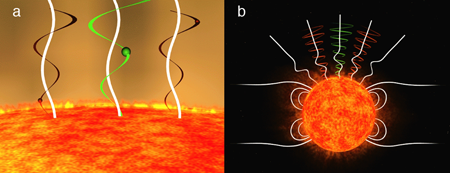What keeps the solar wind hot?
Fifty years after Eugene Parker put forward his theory of the hot outflow of charged particles from the sun called the “solar wind” [1] and its subsequent discovery by satellite-borne instruments [2], scientists still don’t understand the subtle plasma physics behind the acceleration and heating of the sun’s extended corona. New in situ measurements published in Physical Review Letters [3] by J. C. Kasper (Harvard-Smithsonian Center for Astrophysics), A. J. Lazarus (MIT Kavli Institute for Astrophysics and Space Science), and S. P. Gary (Los Alamos National Laboratory) confirm the role of one of the key plasma heating processes.
The sun is a hot ball of gas undergoing fusion at its core, dominated by the proton-proton chain reaction. Gamma rays produced in the nuclear reactions keep the core hot enough to withstand gravity and diffuse outward to leave the sun with a blackbody “photospheric” temperature of around 6000 K. Above the photosphere, the solar atmosphere transitions rapidly to a much hotter ( ∼ 1 million K) supersonic plasma exosphere (the solar wind), made up primarily of protons ( ∼ 95%) and alpha particles ( ∼ 5%) with some trace heavier ions. This exosphere is also what plasma physicists call super-Alfvénic: it is marked by the presence of magnetohydrodynamic waves (named after physicist Hannes Alfvén), which involve collective oscillations of the magnetic field and ions [Fig. 1(a)]. Thus these waves may be capable of transporting huge amounts of energy. Moreover, the plasma flow is accelerated to speeds faster than the Alfvén waves (super-Alfvénic). The solar wind comprises an enormous bubble around the solar system extending out beyond the planets to the “heliopause” where its pressure is matched by the pressure of the local interstellar medium.
This transition from a cool, dense photosphere to a hot, flowing corona is the puzzle. The problem boils down to three broad questions: (i) what is the energy source for the solar wind, (ii) how does this source couple to the corona, and (iii) how is the energy converted to heat? Several theories exist regarding the energy sources and coronal coupling [4] and all of these theories rely on a combination of collisions and the dissipation of Alfvén waves and turbulence to provide plasma heating [5].
One of the key diagnostics of solar wind heating is the observation of preferential “perpendicular heating” of minor ions in the inner heliosphere by the Ultraviolet Coronagraph Spectrometer (UVCS) instrument on the European Space Agency’s (ESA) SOHO satellite. UVCS observations of minor ions ( O5+) show strong heating perpendicular to the local magnetic field, i.e., T⊥/T∥≫1 [6]. This strong perpendicular heating is the hallmark of cyclotron-resonant heating by left-handed polarized Alfvén waves [7]. The scenario is thus: as large amplitude Alfvén waves propagate out in the solar wind, they come into cyclotron resonance with the various minor ions, whose cyclotron frequencies fall off with altitude in the diverging magnetic field. This resonant energy transfer ultimately shows up as heating of the solar wind [Fig. 1(b)].
Kasper and colleagues used a “Faraday cup’”experiment [8] on NASA’s WIND spacecraft to measure in situ the speeds, densities, and temperatures of several million independent parcels of solar wind plasma near 1 AU (1 AU or astronomical unit is the distance from the earth to the sun). A Faraday cup is a simple instrument that measures the electrical current of the flowing plasma on several collector plates as a function of energy. Assuming a form for the velocity distribution function (e.g., Maxwellian) and the constituents of the plasmas (protons and alphas), this measurement provides the densities, parallel and perpendicular (to the magnetic field) pressures, and relative speed between the species.
After removing data dominated by Coulomb collisions, Kasper et al. show that the temperature anisotropy T⊥/T∥ is a strong function of the differential speed between the protons and alpha particles. When the alphas are moving with the protons (low differential speed) they are strongly anisotropic ( T⊥/T∥>1), showing clearly that resonance with the Alfvén waves in the proton frame provides the perpendicular heating of the alpha particles and confirming the resonant heating process.
Two space missions planned for the next decade, NASA’s Solar Probe Plus and ESA’s Solar Orbiter will attempt to solve the coronal heating problem. Solar Probe Plus will dive into within 9.5 solar radii, while Solar Orbiter hangs above. By combining precision in situ measurements (similar to WIND) on Solar Probe Plus with Solar Orbiter’s remote sensing capability (like SOHO), scientists hope to make the coordinated measurements required to solve this mystery of astrophysics once and for all. Meanwhile, Kasper et al. have shown that the cyclotron heating process is active and the next generation of experiments will determine its role in the overall process of coronal heating and evolution.
References
- E. N Parker, Astrophys. J. 128, 664 (1958)
- M. Neugebauer and C. W. Snyder, Science 138, 1095 (1962)
- J. C. Kasper, A. J. Lazarus, and S. P. Gary, Phys. Rev. Lett. 101, 261103 (2008)
- J. A. Klimchuk, Solar Phys. 234, 41 (2006)
- A. Verdini and M. Velli, Astrophys. J. 662, 669 (2007)
- S. R. Cranmer, A. V. Panasyuk, and J. L. Kohl, Astrophys. J. 678, 1480 (2008)
- J. V. Hollweg and P. A. Isenberg, J. Geophys. Res. 107 (A7), 1147 (2002)
- K. W. Ogilvie et al., Space Science Rev. 71, 55 (1995)





